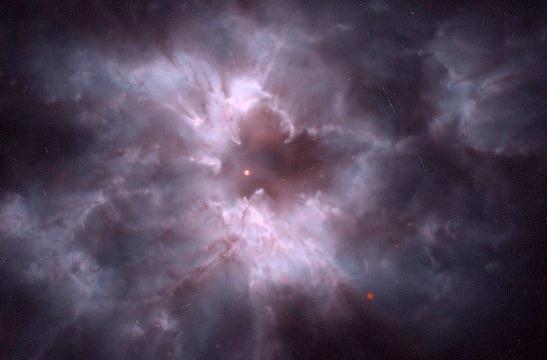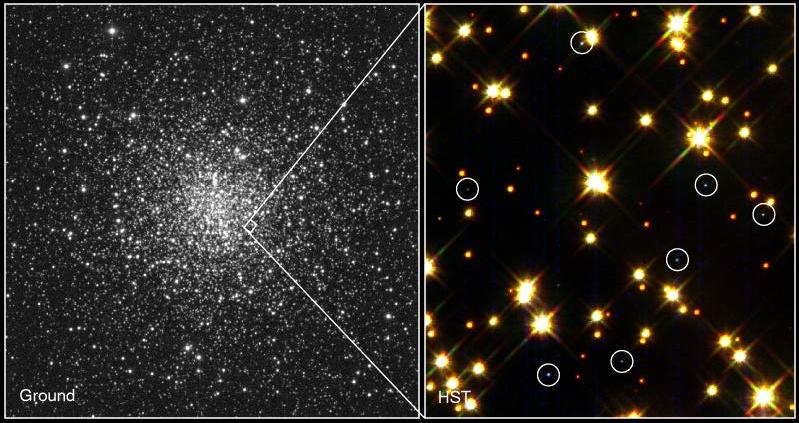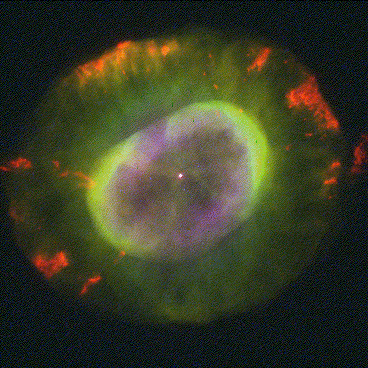 |
| Nearby planetary nebula NGC 2440, surrounding a piping hot white dwarf with a surface temperature of 200,000 degrees Celsius. [NASA/HST, H. Bond, R. Costello] |
White dwarfs are the burned-out cores of collapsed stars that, like dying embers, slowly cool and fade away. They are the remnants of low mass stars, among the dimmest objects observable in the Universe. They are low to medium (less than ten solar mass) Main Sequence stars which have burned through their reservoirs of both hydrogen and helium, passed through the giant phase, were not hot enough to ignite their carbon, puffed off their outer layers to form colorful planetary nebula, and then collapsed and cooled into small glowing coals. This beautiful Hubble Space Telescope image shows a nearby white dwarf, and the outer layers of the former star's atmosphere which have been blown away. The resultant planetary nebula will shine for the next 20,000 to 50,000 years, expanding outwards and fading slowly with time.
 |
| Nearby planetary nebula NGC 2440, surrounding a piping hot white dwarf with a surface temperature of 200,000 degrees Celsius. [NASA/HST, H. Bond, R. Costello] |
A typical white dwarf has a carbon and oxygen mass similar to the Sun, but is much smaller in size (similar to the Earth). It is much hotter (25,000 K), but because of its small size its luminosity is low. How then can we find them?
 |
| The nearby globular cluster M4, observed from the ground (left) and with the Hubble Space Telescope (right). [NOAO/KPNO, M. Bolte & NASA/HST, H. Richer] |
With such a large mass concentrated into such a small size, we can deduce that white dwarfs are extremely high density objects. In a normal Main Sequence star, the pressure of gravity is withstood by the forces of nuclear fusion. In a white dwarf, however, all nuclear fuel has been exhausted and gravity compresses the core inwards, forcing the matter into a degenerate state. We find ionized carbon and oxygen, and a sea of electrons which have been forced out of the atoms.
Degeneracy pressure (by degenerate we mean that the electrons
and the protons have separated) may sound complicated, but it is actually a
familiar process. It is no more than the pressure that prevents liquids and
solids from being compressed. Gas pressure is squishy, and
gases are compressible, as you can verify by pumping your bicycle tire with a
hand pump. At a density of a few grams per cubic centimeter, however,
ordinary matter becomes liquid or solid and is nearly incompressible. Squeeze
on any solid object, and it will push back. No apparatus on Earth can
compress water (or steel) to half its volume. The same degeneracy pressure
prevents atoms from collapsing within white dwarfs. Moreover, the tendency of
liquids and solids to resist compression is almost independent of their
temperature. Liquids and solids do not shrink much when cooled, even to
almost absolute zero temperature (-273 C). Contrary to our usual experience,
if we could heat a balloon of degenerate gas it would not expand. This has
very important consequences for thermonuclear reactions, such as those that
occur in stellar cores. Because of this, a white dwarf is able to radiate
heat and slowly cool down, without the internal pressure dropping. (Contrast
this with the pressure due to the heat and excitation of nuclear reaction when
the star is in its Main Sequence hydrogen-burning phase: without the heat, the
pressure drops and gravity wins the battle to compress the star.)
The white dwarf comes slowly to the end of its life story. It has no
nuclear hydrogen or helium left to burn and it will have no further major
structural changes. Because of its small size, high density, and initially
hot temperature, it takes billions of years for a white dwarf to radiate all
of its residual heat into space. It will take many millions of years before
it cools off enough that it becomes invisible (a black dwarf). As it cools,
the carbon atoms will crystallize into diamond lattice, a single diamond with a
mass equal to 300,000 times the entire Earth! But don't count on getting
rich mining this black gold ... the gravitational force on the surface of a
white dwarf star is 300,000 times that of Earth, and you would weigh 30
million pounds there. Just enjoy the thought that billions of such diamonds
really exist!

The Blue Snowball planetary nebula (also
known as NGC 7662), centered around a small, faint white dwarf.
[NASA/HST, B. Balick]